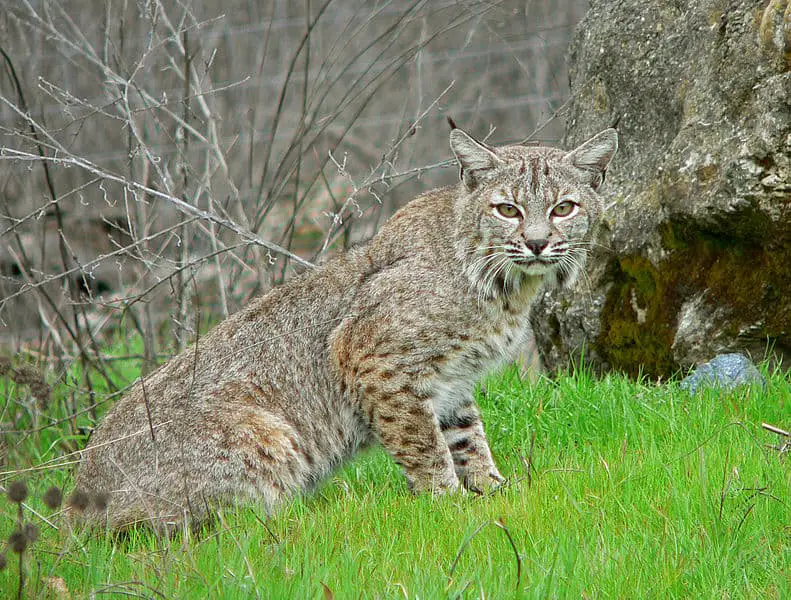The only wild cat that still remains in Massachusetts is the bobcat. There are around 3,500 bobcats in Massachusetts which mostly reside in the western parts of the state.
What’s more, the bay state has two other native species of wildcat that have become extirpated from its boundaries. These are the mountain lion and the Canada lynx.
We’ll talk about all three of these wild cat species in the paragraphs below.
Bobcats in Massachusetts (Lynx Rufus)
The bobcat, which is also known as the red lynx, the bay lynx, or the swamp tiger, is a North American wild cat. Biologists believe that both the bobcat and the Canada lynx are descendants of the Eurasian lynx whose ancestors crossed into North America via the Bearing Sea land bridge.
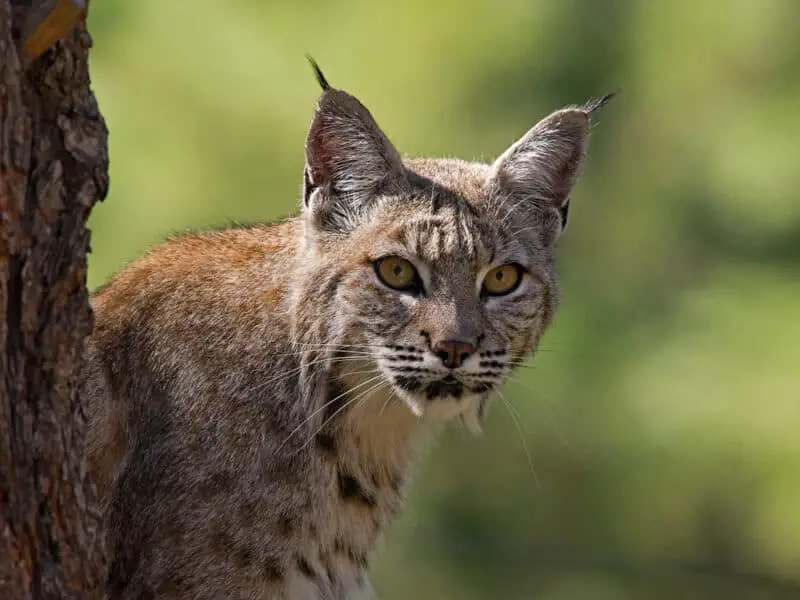
Where do bobcats live?
Bobcats reside only in North America. They’re also the most common wild cat in North America. Their range begins in southern Canada and then extends south through most of the continental United States and down into central Mexico.
There are bobcats in Massachusetts, just as there are in all the New England states. There are bobcats from Cape Cod in southeastern Massachusetts to Williamstown in the northwest. Their population varies across the state. However, the greatest bobcat population densities are in western Massachusetts.
According to Dave Wattles, who works as a Black Bear and Furbearer Biologist for the Massachusetts Division of Fisheries and Wildlife, historically, bobcat populations have mainly been in the western two-thirds of Massachusetts. However, they are ever increasingly expanding east. See
Bobcat sightings are rare because they are mostly nocturnal or crepuscular animals. Your best chances of spotting one are in the early morning and early evening hours.
Other than their inability to cope with deep snow, bobcats are pretty versatile and tend to utilize all the different habitat types within their range. In Massachusetts, bobcats inhabit mountainous areas with rocky ledges, hardwood forests, swamps, bogs, and brushy areas. They also exist in but are less frequently in agricultural areas and suburban areas. They also seem to thrive in wooded areas in close proximity to clear cuts. Studies show that small mammal populations increase in clear-cut areas. This is due to the improved food and cover conditions that a clear-cut creates. See
Sometimes people in rural or even suburban and urban residential areas have bobcats in the neighborhood, and they don’t realize it. It’s a very rare occurrence, but sometimes these animals will end up in someone’s home or garage. If you ever accidentally corner a bobcat, immediately give it some space. Back away and leave a door open for it to escape on its own. Do not approach a cornered bobcat. These are dangerous wild animals and will do their best to tear you up if they feel the need to defend themselves. If you have an intruding bobcat that won’t leave on its own, call on your local fish and game officer to remove it for you. See also See
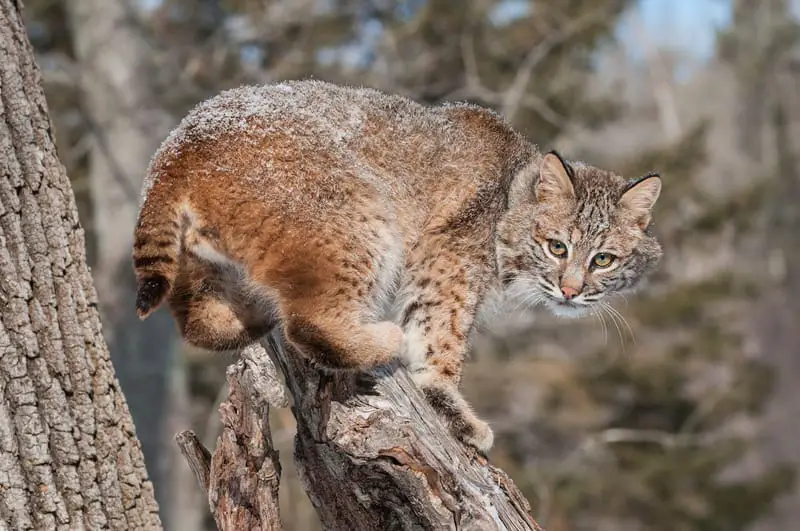
What do bobcats look like?
Adult bobcats are similar to their close relative, the Canadian lynx, in appearance, with some differences. An Adult bobcat is slightly smaller than an adult Canada lynx.
Compared to Canadian lynx, which thrive in deep snow country, bobcats struggle more in the snow due to the fact that they cannot walk on top of it as lynx can. A lynx’s large paws function like snowshoes keeping it on the snow’s surface. They have evolved this characteristic to hunt snowshoe hares in the winter. On the other hand, compared to lynx, bobcats have small feet that tend to sink into the snow. If the snow is too deep and powdery, it reduces their mobility along with their ability to catch prey.
A bobcat is roughly twice the size of a domestic house cat. They are 2 to 3 feet long and weigh 15 to 35 pounds. Adult male bobcats are around 33% larger than female bobcats.
These animals have “bobbed,” short tails with black tips and black bars on the upper surface. The black tip on their tail is only on its upper surface but not the back. As opposed to a lynx’s tail which looks like it was dipped in black paint.
Their fur is usually gray to brown, with mottled dark spots that range from black to dark brown on their bodies. “A note on this is that in the eastern U.S., bobcats have fewer spots on their bodies than bobcats in the west do.” They also have black stripes on their inner forelegs and tail.
From a side view, you will notice that a bobcat is slightly higher at the rump than at the shoulders. Bobcats and lynx have long hind legs in proportion to their forelegs.
Bobcats have black-tufted ears. In other words, they have short tufts of black hair that poke up above their ears and are black at the tips. The backs of their ears, below the black tips, are black. In the center of the black of each ear, they have a single white spot. This gives the impression of a false eye on the back of each ear.
They also have a whiskered face that seems broader due to their prominent face ruff and whiskers. Their eyes are yellow with round black pupils.
In 2020, film footage of a rare black bobcat was taken near Danville, Vermont. See. These melanistic bobcats have all the markings that non-melanistic ones do. They manifest as darker black spots on top of lighter black or dark grey.

What do bobcats eat?
Despite their comparatively small size, bobcats are aggressive, tough predators. At times, particularly during the winter, they take larger animals that are quite a bit bigger than they are, such as deer. In Massachusetts, for instance, they sometimes prey on white-tailed deer.
However, their regular diets mainly consist of small mammals such as cottontail rabbits, woodchucks, squirrels, chipmunks, mice, and voles. They also feed on reptiles, birds, insects, and carrion. When they take up residence close to a residential area, their menu might occasionally also include small livestock, poultry, or small pets.
They even prey on venomous snakes when the opportunity arises despite not being immune to the venom. They accomplish this by using their quickness to pin the snake’s head down with a paw, after which they dispatch the snake with a quick bite to its spine behind the head.
The venomous snakes in the state of Massachusetts are the Eastern Copperhead (Agkistrodon contortrix) and the Timber Rattlesnake (Crotalus horridus) See
What eats bobcats?
In Massachusetts, coyotes, domestic dogs, great horned owls, fisher cats, and foxes may occasionally kill young bobcats. Other than that, these felines have no real predators.
Reproduction and life cycle for eastern bobcats in Massachusetts
The mating season for bobcats is in February and March. Bobcats are polygamous. This means that a male bobcat may mate with multiple females. Radio-collared males have been observed to travel up to 20 miles in a single night to get to a female in estrus.
If they successfully mate, the gestation period for bobcats is 60 days.
After breeding, the male and female go their separate ways. Other than in the exceptions of breeding and raising young, they’re solitary creatures.
The female takes all responsibility for the selection of a den site and the rearing of the young.
Bobcats often use rock crevices as den sites but may also den in the cavity beneath an overturned stump or beneath a blown-down tree,
In Massachusetts, the bobcat litter size ranges from 1 to 4 kittens. The average size is 2.
Bobcat kittens are born with their eyes sealed, just like domestic cats are. However, their eyes will open when they are a week to 10 days old. By the time they are 2 months old, they will have replaced their spotted baby fur with a haircoat similar to what their parents have.
By mid-July, the kittens begin to venture out with their mothers to fine-tune their survival skills. Their training may last into the early winter. By mid-winter, the kittens strike out on their own.
Female bobcats reach sexual maturity at 1 year of age, while males reach sexual maturity at age 2.
In Massachusetts, bobcats live an average of around 12 years in the wild. See
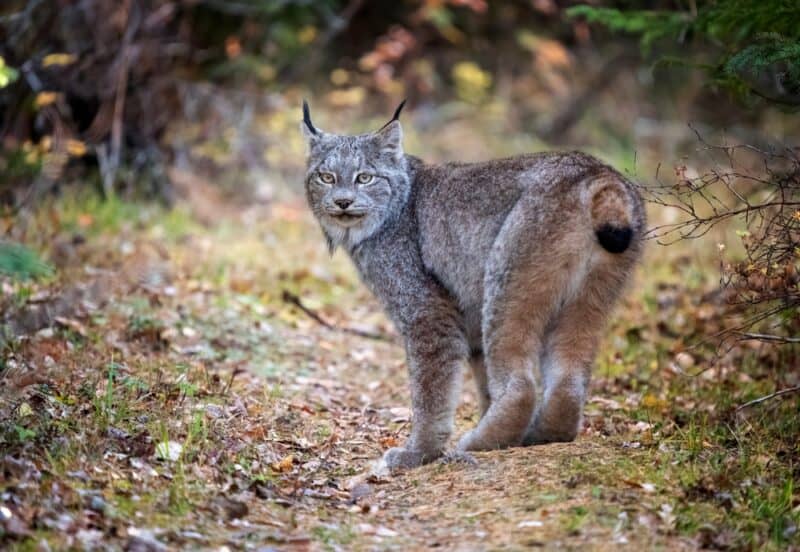
Canada Lynx In Massachusetts (Lynx canadensis)
The Canada Lynx is sometimes also known as the Canadian Lynx. They are medium-sized wild cats that live in the boreal forest in the mountainous areas of Canada and the northern United States. They are 1 of 2 North American members of the “Lynx” genus. The other one is the bobcat.
The majority of the World’s Canadian lynx population lives in the dense forests in the boreal regions of Canada, Alaska, and the northern contiguous United States.
In the United States, there are Canada lynx populations in Alaska. In the contiguous United States, there are lynx in the northern states of Maine, New Hampshire, Vermont, Minnesota, Montana, Idaho, and Washington. There are also lynx in Colorado and possibly northeastern Utah and northern New Mexico.
Before the time of European colonization, Canada lynx ranged throughout the area that now comprises New England, including Massachusetts. However, today they are completely extirpated from the states of Massachusetts, Rhode Island, and Connecticut. On the other hand, Canada lynx are still present in Maine, New Hampshire, and Vermont.
The U.S Fish and Wildlife Service listed the Canada lynx in the contiguous United States as a threatened species under the Endangered Species Act in the year 2,000. Therefore, they are protected under federal law.
Canada Lynx Characteristics
What does a Canadian lynx look like? The Canadian Lynx closely resembles its close relative, the bobcat but with some differences. First of all, they are slightly larger than bobcats with longer legs. They are up to 35 1/2 inches (90 cm) long and 26 inches (65 cm) tall. Additionally, they weigh up to 37 and a half pounds (17 kg). While bobcats have “bobbed”, short tails, a lynx’s tail is shorter still.
Lynx don’t have the black bands on the topside of their tails that bobcats have. However, they do have black tips on the ends of their tails. One more difference is that the black tip on a lynx’s tail surrounds the entirety of the tail as if the tail had been dipped in black paint. On the other hand, the black tip is only on the top side of a bobcat’s tail.
Canada Lynx have long, thick grey fur in the winter. By summertime, they have shed their grey fur and have a thinner, shorter reddish brown hair coat instead. Their color is more uniform than that of bobcats. While bobcats have black spots and mottled coloration over their entire body, Lynx are solid tan except for some mottled darker brown spots on their legs.
Canadian Lynx have triangular pointed ears with black backs and long ear tufts of black hair on the tips. They have longer ear tufts than bobcats do. They also have drooping flared facial ruff of white hair on the sides of their face beneath their chin.
Their eyes are green with round black pupils.
Lynx have long legs in proportion to their bodies, with their hind legs being slightly longer than their front ones. This gives their body a peculiar, downhill-sloped appearance.
Canadian Lynx have almost comical-looking oversized furry feet. They put their larger feet to good use. Their large paws function like snowshoes, allowing them to travel and hunt on top of the snow. Canadian lynx feet can keep almost twice as much weight from sinking into the snow as those of a bobcat. This is why they range over the deep snow country of northern Canada while bobcats do not. See
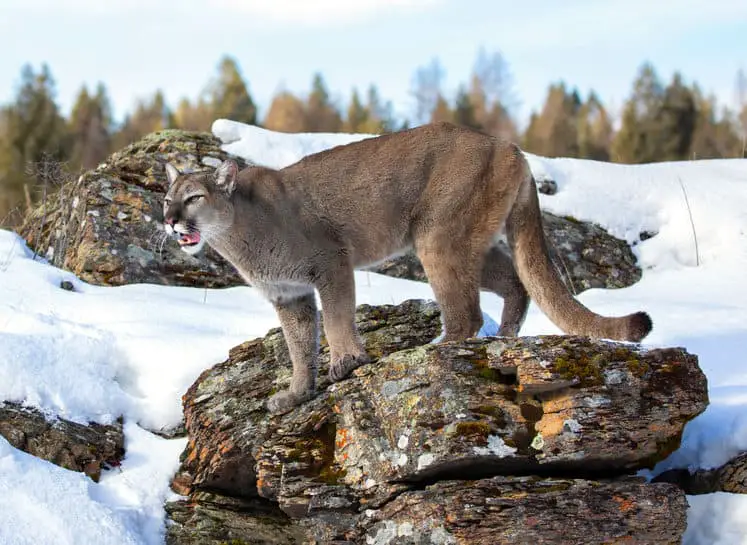
Mountain lions in Massachusetts (Puma concolor)
As with the Canada lynx, before the time of European colonization, mountain lions ranged across what is now the state of Massachusetts as well as all of the eastern United States and Canada. However, civilization and the eastern cougar did not mix well. Farmers did not appreciate mountain lions preying on their livestock. Consequently, state and local governments placed bounties on them.
Also, unregulated hunting eliminated the eastern elk and drove white-tailed deer, which were the main prey animal for the Massachusetts mountain lion, to the brink of extinction.
The last known mountain lion in Massachusetts was killed around 1858. What’s more, the last documented cougars in the northeast were killed in New Brunswick, Canada, in 1932 and in Maine in 1938. See
Today the only known population of mountain lions in the east resides in Florida. A Florida mountain lion is called a Florida panther.
Despite the fact that mountain lions have been largely absent from the state for a long time, Massachusetts residents continue to call the Massachusetts Department of Fish and Game with mountain lion sightings. These include eyewitness accounts as well as cell phone footage and photos from trail cameras.
The vast majority of the accounts of mountain lions in Massachusetts are cases of mistaken identity, which could involve anything from a large bobcat to a coyote or domestic dog.
There have, however, been 2 confirmed reports of mountain lions in Massachusetts.
The first one occurred in 1997 when scat which was collected at the Quabbin Reservation, was confirmed by DNA analysis to be from a mountain lion.
The second occurrence took place in 2011 when photographed tracks that were found near the Quabbin Reservoir were authenticated to be made by a mountain lion.
Despite these occurrences, the MDWR states that there is no evidence of a breeding population of mountain lions within the state.
It attributes these sightings to wandering individuals from established breeding populations in states in the west or mid-west. Young males from established breeding populations travel long distances, sometimes looking to establish their own territory free from dominant males.
A famous case of this occurred in 2011. A young male cougar traveled all the way from South Dakota before he was struck and killed by a vehicle in Connecticut. See
Recent Posts
The only venomous snakes in Washington State are Northern Pacific Rattlesnakes. The Northern Pacific Rattlesnake (Crotalus oreganus oreganus) is a sub-species of the Western Rattlesnake. Anyone...
Skunks are not classified as true hibernators. But they go into a state of torpor when the weather gets cold. Skunks are light sleep hibernators, along with opossums, bears, and raccoons. ...

